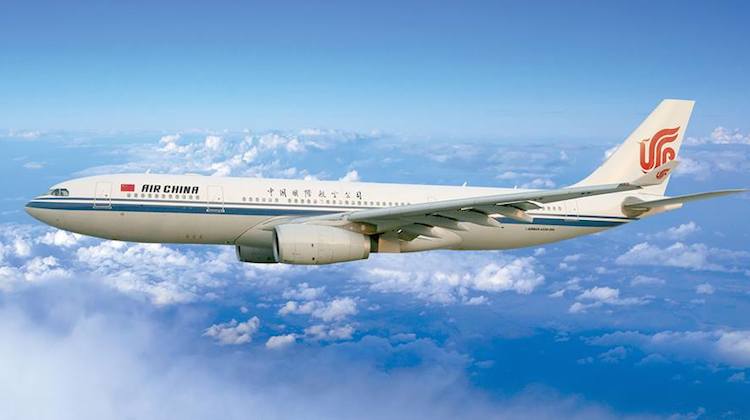
Air China will offer the only direct flight between Melbourne and Beijing when it starts Airbus A330-200 service on the route from June 1 as the Australian government opens up more capacity for Chinese carriers to Australia.
The Chinese flag carrier has opened reservations for the new flights, which will operate four times a week, Airline Route website reported.
Currently, the airline offers a same-plane one-stop service from the Victorian capital to Beijing via Shanghai. It also flies nonstop from Sydney to Beijing and Shanghai.
Air China’s expansion Down Under comes as the Australian government confirmed on Friday it had negotiated a new air services agreement with China which significantly increased the number of available seats for both Australian and Chinese carriers over the next two years.
The current cap on flights between Australia’s four main gateway airports – Brisbane, Melbourne, Perth and Sydney – to Beijing, Guangzhou and Shanghai has been immediately lifted by 4,000 seats, or 18 per cent, to 26,500 seats per week.
This figure rises to 30,500 seats per week in October 2015 and to 33,500 seats per week from October 2016.
The new bilateral also includes for the first time a separate allocation of capacity for travel between Australia’s four gateway cities and Chinese cities other than Beijing, Guangzhou and Shanghai.
That means the current limit of 22,500 seats per week before Friday’s announcement will increase to 67,000 seats per week by October 2016.
Tourism and Transport Forum chief executive Margy Osmond said Australia was a “very aspirational destination for the emerging middle classes”.
“The agreement is evidence of the federal government’s commitment to ensuring tourism policy reform also encourages economic development,” Osmond said in a statement.
“This approach means reforms such as these are not just good for tourism, they are good for Australia.”
Sydney Airport chief executive Kerrie Mather said the new allocation of specific capacity for flight from second- or third-tier Chinese cities would help serve “growing demand from these regions”, given Chinese carriers had reached their capacity limits.
Mather, who was in China this week for discussions with airlines, noted the number of Chinese tourists to Australia grew by 16.4 per cent in 2014 and China was forecast to overtake New Zealand as Australia’s largest inbound market in 2016.
“We have been in discussions with a number of Chinese airlines that want to fly to Sydney, but the existing agreement has been at capacity over the peak season for a number of years,” Mather said in a statement on Friday.
“This agreement will enable airlines to capitalise on this market’s consistently strong growth.
“Some of our largest unserved markets are outside of the primary hubs of Beijing, Shanghai and Guangzhou and our strategy is to attract more visitors from these cities.”
Deputy Prime Minister and Minister for Infrastructure and Regional Development Warren Truss says the new agreement opened up opportunities for Australian airlines to better serve China.
“The Australian Government is committed to ensuring that we have the aviation capacity necessary to meet future demand into and out of foreign markets and recognises the potential of Australia as a prime tourism destination within the Asia-Pacific region,” Truss said in a statement on Friday.
Chinese carriers are already well represented in Australia.
Although Air China, China Eastern, China Southern and Sichuan Airlines sit outside the top 10 largest carriers operating into and out of this country, collectively they accounted for 4.6 per cent of all international passengers in 2013/14 according to figures from the Bureau of Infrastructure, Transport and Regional Economics (BITRE).
The trio carried more passengers to Australia than AirAsia X (4.2 per cent), Thai Airways (2.8 per cent) and Malaysia Airlines (4.4 per cent), while it was just below aviation powerhouse Cathay Pacific which is at 4.7 per cent.
Qantas is the only Australian flag carrier offering direct flights to China with a daily Airbus A330 flight between Sydney and Shanghai.
The Flying Kangaroo has applied to the Australian Competition and Consumer Commission (ACCC) seeking regulatory approval for an alliance with China Eastern on Australia-China services.
Trade Minister Andrew Robb said the new air services agreement was part of the recently concluded free trade agreement between Australia and China.
Moreover, Robb said the boost to aviation capacity ensured Australia was well-placed to “capture our share” of the expected growth in Chinese tourists heading overseas.
He noted 100 million Chinese travelled abroad in 2014 and the figure was expected to reach 200 million by the end of the decade.
“China is our most valuable tourism export market. This agreement – along with the launch of the recent pilot program for online visa applications by Chinese visitors – means our tourism sector is well primed for 2015,” Robb said in a statement.
The bilateral maintains unlimited capacity for flights from all cities in Australia other than the four gateway cities to China.
Meanwhile, Australian airlines will have expanded right to fly beyond China, including to Europe, and to China via intermediate points.










